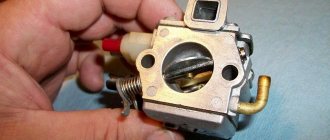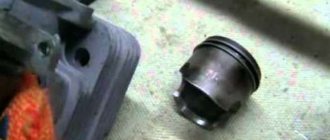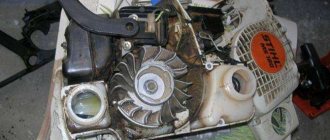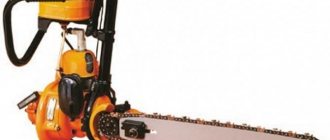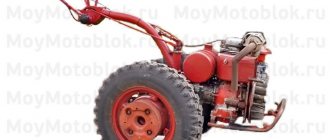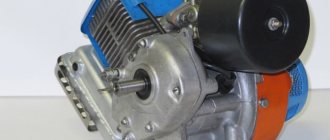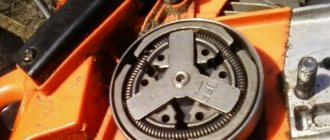Swedish Husqvarna chainsaws are presented on the market with professional and household class models. Excellent performance, service life, and versatility make the manufacturer’s tools in demand on the world market. Reliability and durability are also ensured by high-quality assembly of chainsaws, parts made of forged steel and durable plastic.
Design and scope of use
The use of the Husqvarna 240 chainsaw is not limited to standard functions for preparing firewood. With its help, you can easily clear a large area of bushes and old trees, form crowns of ornamental plants in the garden, and use it in construction for cutting boards. Sufficient power and length of the bar allow sawing wood both lengthwise and crosswise.
The classic design of the brand is combined in this model with high technical characteristics and ease of use. The Husqvarna 240 saw belongs to the household class, but its performance is not much different from professional tools. Manufacturers have provided this saw with such necessary functions as easy starting, double air purification, and vibration reduction. Ergonomic control levers and handles provide maximum operating comfort and reduce the load on the operator. The main components of the mechanism are located in such a way as to speed up and simplify access to them in case of repair.
If you follow the operating instructions and regularly carry out preventive inspections of the chainsaw, repairs can be avoided in most cases. But even in the event of a breakdown, the tool will not cause you significant inconvenience - original spare parts can be easily purchased and replaced. The detailed structure of the Husqvarna 240 chainsaw is shown in the diagram below:
Consequences of modernization
To create this model, a classic layout was used in combination with modern industrial design, innovation and original technical developments of the company’s design bureau.
In particular, compared to similar models, the reliability and efficiency of starting and air purification systems, operator comfort, and the amount of routine maintenance have been reduced.
The Husqvarna 240 chainsaw belongs to the household class, but its functionality and performance characteristics are as close as possible to chainsaw equipment of the semi-professional category. This is confirmed by the ability of the tool to work with wood with a cross-section of up to 300-350 mm.
Technical characteristics of the Husqvarna 240 chainsaw
The basis of the Husqvarna 240 saw is a 2-stroke engine with a carburetor.
Runs on a gasoline-oil mixture. The engine life is increased due to improvements in the crank assembly and a special cylinder coating. Fuel economy is reduced by 20% thanks to the innovative X-Torq system, which also reduces the harmfulness of exhaust gases. A spacious fuel tank and low fuel consumption extend the operating time of the tool, without interruption for refueling. Otherwise, the saw has the following technical characteristics:
- productivity – 2 l. With.;
- chain pitch - 3/8 inch;
- fuel tank capacity – 300 ml;
- oil tank – 200 ml;
- tire length – 40 cm;
- weight – 4.7 kg.
Chainsaw chain
The advantage of these chainsaw models is the standard parameters of chainsaw chains. Almost any chain with a bar length (40 centimeters in general) with a groove width of 1.3 millimeters will do, the chain pitch depends on the model. For those starting with “1” - 3/8″ - which is true for model 135, for analogues starting with “4” - 0.325″.
In any case, you can use any chains for a chainsaw; it is only important to monitor its tension. To adjust the chain tension, you should use an adjusting screw and the rule is that the chain should not sag on the bar, sit quite firmly, but at the same time should not interfere with the rotation of the sprocket; when turned off, the chain should easily scroll along the chainsaw bar by hand. Announcement:
Announcement:
An important feature when adjusting is that during operation the chain stretches slightly, so it is necessary to periodically check its tension. Correct adjustment will be in increments of 1/4 turn of the adjusting screw.
How to adjust the carburetor on a Husqvarna 240 chainsaw?
Any equipment is prone to breakdowns from time to time. The main malfunctions of the Husqvarna 240 chainsaw are related to the repair of the carburetor, other components of the fuel system, and malfunctions of the oil pump. If the oil pump breaks down, the chain for the Husqvarna 240 chainsaw stops rotating due to lack of lubrication. Also, damage to the gas tank or fuel hoses may be the reason why gasoline leaks from the saw. If the saw completely stops starting, you should first make sure the quality of the fuel mixture and check the spark plug. If necessary, clean the spark plug or replace it with a new one, and adjust the carburetor.
Carburetor adjustment is also required in cases where the chainsaw begins to start poorly, stalls under load, and also if the type of fuel or operating conditions have changed. It is worth adjusting the carburetor after preliminary cleaning of the air filters and warming up the engine.
Next, follow this algorithm:
- Screw L is turned to maximum. Then immediately return the screw a quarter turn back.
- While holding the throttle, turn screw H a quarter turn.
- Release the gas and turn screw T clockwise until the chain begins to move. After this, immediately turn the screw back until the chain stops.
The location of the corresponding screws is shown below:
Modern chainsaws have a complex system and consist of several main components that periodically require maintenance and adjustment. In this article we will talk about how to adjust the carburetor on a Husqvarna chainsaw.
Reliability of chainsaws
The 236 Husqvarna model is considered quite reliable, and if used correctly, it does not cause problems for owners. When a tool is used and stored incorrectly, the first thing that can fail is the carburetor.
Like all chainsaws equipped with two-stroke engines, the Husqvarna 236 is very sensitive to the cleanliness of the air entering the cylinder. In this case, if the owner of the tool does not control the cleanliness of the air filter and does not change it over time, the CNG of the saw will fail much faster. This is a very serious problem, the solution to which is to carry out a major overhaul.
READ Synthetic Marble Countertop How to Cut
For more information on Husqvarna chainsaw problems and how to fix them, please see the Husqvarna repair article on our website. The article contains information on how to remove the cylinder, what to do if the oil leaks or when the Husqvarna 236 starts and stops.
Vladimir is 36 years old. Tyumen.
I bought my chainsaw over 2 years ago. At first I was a little upset because I thought it was a little lacking in power, but after I visited the service center and adjusted the carburetor on the saw, the engine ran at full speed and the chainsaw improved performance significantly.
During the entire period of operation in sawmills, I work on sawmills, the 236th practically did not break down. I change the filter on time and try to keep the saw clean. After every working day I clean it with a compressor. In my opinion, this is what allows it to work without breakdowns.
But there were still breakdowns. After a year of use I had to replace the starter cord, but I think it's a minor thing. There were also some starting problems, but they went away after I replaced the fuel filter. In general, I have not heard of such chainsaws starting out badly.
I advise you to use only quality Husqvarna oils because I use them and am very happy with them. Even to lubricate the chain, I used a special adhesive oil and noticed that the bar and sprocket lasted much longer than my colleagues who save and refill used oil from car engines.
I recommend it to everyone, the chainsaw is worth the money spent on it.
The design and principle of operation of the Husqvarna carburetor
To successfully configure the Husqvarna chainsaw carburetor, you need to know its structure and understand how it works. In fact, everything is not as complicated as it seems at first glance.
The saw carburetor has a built-in fuel pump, which is responsible for transporting the mixture of gasoline and oil, as well as a diaphragm, a needle valve with a rocker arm. Their joint work makes it possible to dose the fuel supply to the main chamber and two dampers.
One of the dampers is designed to regulate the flow of fuel into the cylinder when you press the gas, it is called the throttle, the second is responsible for limiting the flow of air from the air filter to facilitate starting a cold Husqvarna chainsaw. At the moment when the operator shuts off the air supply to the carburetor using the air damper, the fuel mixture becomes leaner and its supply to the cylinder increases, due to which the chainsaw starts much easier than when a cold start is carried out in normal mode.
The operation of the Husqvarna carburetor involves a valve-nozzle, which atomizes fuel and prevents air from entering the main chamber. Often problems with saw operation can be caused by defects in this particular element. For example, if the chainsaw is stored improperly, the valve may stick, the fuel supply will stop, which will make the engine impossible to operate. Also, malfunctions in the operation of the nozzle can cause air to leak into the main fuel chamber of the carburetor. In such cases, adjusting the position of the adjusting screws will not correct the situation; repair or replacement of the unit will be required.
Three adjusting screws installed in the carburetor body are responsible for adjusting the quality and quantity of the mixture, as well as the number of crankshaft revolutions in idle mode:
- screw (L) – regulates the amount of fuel in low and medium speed modes;
- (H) – responsible for traction at high speeds and their number;
- (T) - changes the position of the throttle valve, thereby regulating the amount of fuel mixture entering the cylinder and the operation of the tool engine in idle mode.
Screws (L) and (H) cannot be adjusted without specific knowledge and experience. Incorrect adjustment of the quality and quantity of the fuel mixture can cause the engine to stop working or operate incorrectly, causing it to wear out quickly or even seize.
Basic malfunctions and ways to eliminate them
When starting to repair a chainsaw, you need to have an idea of what malfunctions it may have, as well as how these malfunctions are eliminated. So, let's look at the signs of malfunctions and how to fix them.
Husqvarna chainsaw does not start
If the Husqvarna does not start, the first thing you need to make sure is that you follow the algorithm for starting the saw, as well as the presence of fuel in the tank. Detailed instructions on how to start a cold chainsaw and refuel it are available in the saw manual that comes with all Husqvarna chainsaws.
If you do everything correctly, but the saw does not respond, the reason may be a malfunction of the ignition system or lack of fuel supply.
To more accurately determine the reasons for this behavior of the chainsaw, it is necessary to inspect the spark plug, and then check it for the presence of a spark.
If the spark plug is wet and no spark is detected when checking, you should try replacing the spark plug itself. The replacement did not produce results, which means the problem may be hidden in the ignition coil, which is quite difficult to check on your own.
If there is a spark, but the spark plug is dry, there is a problem in the fuel system. To eliminate it, you need to carry out a full diagnosis. The fuel system consists of a carburetor and a fuel line. Without any specific experience, you can check the fuel line for ruptures, as well as the cleanliness of the fuel filter installed in the tank. It is better to entrust complete carburetor diagnostics and repairs to professionals.
If the saw starts, but poorly
The cause of difficulty starting the saw may be a malfunction or incorrect adjustment of the carburetor. If the carburetor overflows, the chainsaw will be easy to start when hot, but quite difficult when cold, especially after a long period of inactivity.
An indirect sign of an excessive amount of fuel mixture entering the cylinder when the chainsaw is operating is the exhaust. If a lot of white smoke is emitted when the chainsaw is running, it is worth checking the proportions of the fuel mixture and carburetor adjustments.
Chainsaw chain spins at idle speed
If the Husqvarna chain rotates at idle, then we can conclude that there is a malfunction in the clutch mechanism or the idle speed is not adjusted. To eliminate the malfunction, it is necessary to remove the saw chain brake cover and inspect the integrity of the clutch spring. Replace defective clutch.
If the clutch is working properly, to eliminate chain spinning, it is necessary to adjust the idle speed using the adjusting screw marked with the letter (T) or carry out a full carburetor adjustment.
Important: a possible reason for an independent increase in idle speed is the appearance of air leaks into the engine crankcase or carburetor, which can lead to serious damage to the CPG
Why does the Husqvarna chainsaw stall when you press the gas?
If the saw stalls immediately after pressing the gas, it is necessary to inspect the spark plug, which will help more accurately diagnose the problem. A wet spark plug indicates a malfunction or incorrect adjustment of the carburetor; in this case, the situation can be corrected by carrying out a complete diagnosis, repair and adjustment of this unit. If repairs and adjustments do not help, you need to replace the carburetor with a new one.
Another reason why a Husqvarna may stall when you press the gas is a malfunction in the fuel system, or more precisely, difficulty in supplying fuel to the carburetor. It is necessary to check the cleanliness of the fuel filter, as well as the integrity of the fuel hoses.
Why is the chain on the Husqvarna chainsaw not lubricated?
If your chainsaw has completely stopped supplying saw chain lubrication, then you need to check the entire oil system.
There may be several reasons:
- Oil pump malfunction;
- Clogged filter element installed in the tank;
- Oil tank breather malfunction;
- Oil hose rupture;
- Mismatches in the oil hole on the bar and on the saw body (if the supply stopped after installing a new saw bar);
- Clogged oil channel in the saw body;
- Clogged oil supply channel in the tire;
- Oil pump drive gear malfunction.
Tools required for work
Before you start setting up the Husqvarna carburetor, you need to make sure you have all the tools that may be useful. To carry out this type of work yourself, you will need:
- a screwdriver for adjusting screws (H) and (L), it can be bought in specialized stores;
- electronic tachometer for determining crankshaft speed readings (with some experience, you can make adjustments by ear);
- Phillips screwdriver for adjusting screw (T);
- compressor with a blow gun for cleaning the saw before work.
A regular slotted screwdriver will not work for adjustment, since the adjusting screws on Husqvarna chainsaws can have different cross-sections. You will have to purchase a special one, this is a feature of repairing Husqvarna chainsaws; they did everything so that the saw could be repaired only in a specialized Husqvarna service center.
Algorithm and description of Husqvarna carburetor settings
The Husqvarna carburetor is adjusted in the same way as carburetors on chainsaws from other manufacturers are adjusted.
Immediately before adjustment, it is necessary to conduct a complete diagnosis of the saw and make sure that there is no difficulty in supplying fuel or air leaks into the crankcase of the chainsaw. You also need to make sure that the air filter is clean and, if necessary, replace it with a new one.
The work order is as follows:
- On the muffled saw, the factory settings of the Husqvarna carburetor are installed.
- The engine starts and the saw warms up for several minutes.
- By turning the screw (L) clockwise, the position at which the engine develops maximum speed is found, after which the screw must be turned back 1⁄4. If the chainsaw chain rotates, then it is necessary to reduce the idle speed by adjusting the position of the screw (T).
- The next stage is adjusting Husqvarna's power at maximum speed and adjusting its quantity. To do this, the tachometer is connected to a running chainsaw, the throttle is squeezed to full, after which the tachometer readings are checked. If the maximum speed value differs from the maximum number recommended by the manufacturer, then by changing the position of the screw (H), the tachometer readings are returned to normal.
Factory settings
The standard factory settings for the Husqvarna carburetor are the position of the screws (H) and (L), in which a working chainsaw should be guaranteed to start. For Husqvarna tools, this is one and a half turns from fully tightened screws (H) and (L). During the adjustment process, you must first set the screws to the standard position, then start the chainsaw and make precise adjustments to the power, the number of maximum revolutions and idle speed.
READ Where is the Chainsaw in The Forest
Nuances of adjustment
After the adjustment, the chainsaw should easily pick up and drop speed, and operate stably at low and high speeds. If the saw chain rotates at idle speed after adjusting the carburetor control screws, this is a sign that the adjustment was made incorrectly and the position of the screw (T) needs to be adjusted.
Also, when adjusting the Husqvarna carburetor, it is worth taking into account the response time of the chainsaw to the rotation of the screws. The settings do not change immediately, but within five or ten seconds.
One of the indicators of incorrect adjustment is heavy smoking when the saw is operating, which indicates a large amount of fuel entering the combustion chamber. If such a situation occurs, the position of the screw (L) must be adjusted.
Guarantee of operational safety and easy start
The risk of injury in the event of an emergency is minimized due to the high-precision operation of the braking device, which is activated when the upper shield moves slightly in the frontal direction.
A manual starter with an easy start system, a booster pump and an advanced electronic ignition guarantee a successful start of the power unit in conditions of extremely low and high ambient temperatures.
Experts characterize the Husqvarna 142 saw as a fairly comfortable to use, productive, reliable and durable household tool that meets the requirements of modern technical and operational standards.
DIY carburetor repair
If, during a full diagnosis of the Husqvarna chainsaw, carburetor defects were discovered, some of them can be eliminated without contacting the Husqvarna AB service center. For example, you can do this yourself:
- change the gaskets under the covers of the main chamber and fuel pump;
- clean or replace the strainer;
- replace the diaphragm or needle valve of the main chamber;
- troubleshoot the fuel pump diaphragm.
Gaskets, diaphragms and a needle valve with a rocker arm can be found in the repair kit, which is available for each model of Husqvarna chainsaw carburetors.
Also, if you have some experience, you can try to restore a faulty injector valve, but you cannot guarantee a positive result when trying to restore an injector; if it malfunctions, manufacturers recommend replacing the carburetor completely.
The first thing you need to do before removing the carburetor from the Husqvarna is to clean the saw with a compressor, since dirt can interfere with quality repairs. Next, you need to open the top cover of the chainsaw, remove the air filter, and disconnect the rods from the air and throttle valve control levers. After this, unscrew the carburetor mounting screws.
Disassembling the carburetor body for repairs is quite simple. The main chamber cover is held in place by four screws, which can be removed using a regular screwdriver; the fuel pump cover is secured with one wide screw.
Below is a video, after watching which you will understand exactly how you can repair the carburetor without contacting a Husqvarna service center.
Separately about the breakdown of the most common model
Let's look at the problems of Shtil 180 in more detail:
- Clogged carburetor or fuel filter. These are the most common problems that can be easily resolved after cleaning. Sometimes the filter has to be changed;
- Replacing the spark plug;
- Sometimes the cylinder or seals need to be replaced.
The Shtil saw is quite strong and durable, so you can often fix a breakdown yourself. In fact, the same applies to the Partner, Ural, Makita and Husqvarna models.
When we discover a malfunction in our chainsaw, we look for the cause in small ways, gradually checking and eliminating the problems. Such problems are easy to fix yourself. But if the breakdown is serious, and you do not have enough experience, then this should be done by a specialist.
Conclusion
The work of adjusting or repairing the carburetor on Husqvarna chainsaws can be done without any specific experience. In order to do everything correctly, you must follow the algorithm and have a minimum set of tools. It’s also worth assessing your strengths in advance and not taking risks if you don’t understand anything at all about technology. Believe me, sometimes it is better to pay a small amount to the master than to ruin the instrument by adjusting it yourself.
Adjusting the carburetor on a Husqvarna chainsaw
Scope of application
The manufacturer recommends using Husqvarna 240 9673260 01 to solve simple problems. For example, this is work on caring for a garden plot or preparing firewood for individual heating. This model is also suitable for outdoor enthusiasts who need to make tables and benches from wood while traveling, as well as cut wood for a fire.
The engine life of the engine installed on this saw model does not allow it to be used for daily work in an eight-hour working day. Simply put, if you use this saw every day, the piston group will wear out quickly and require repair.
To increase the service life of the piston group, it is necessary to use only original oils manufactured by Husqvarna.
Repairing a piston is quite an expensive task, and it is for this reason that if there is a need to work with a saw every day, then it is better to choose a chainsaw from the professional or semi-professional series. Chainsaw Husqvarna 240 is a household model.
Chainsaw Husqvarna (Husqvarna) 137. carburetor adjustment.
The best advice I can give you is to contact the specialists! Believe me, for very little money, specialists will adjust the carburetor and check the general condition of the saw. But if you still need to adjust the carburetor on the Husqvarna 137 saw without the help of others, then I will try to carefully outline this process. DIY chainsaw carburetor repair. Also at the end of the post I added a video on how to adjust the carburetor of a chainsaw at idle speed.
Husqvarna. Works poorly, stalls. Interesting case
Husqvarna chainsaw repair
.Works poorly, stalls
.Interesting case.
Owners of household chainsaws HUSQVARNA one hundred thirty-seven and HUSQVARNA one hundred forty-two, in case of any deviations in engine operation from the norm, should first check the pulse hose, since this is considered the most common cause of breakdown of these chainsaws.
A video showing how to replace a defective impulse hose on a HUSQVARNA 142 chainsaw with your own hands can be viewed below. It shows step-by-step the process of disassembling the saw, shows the impulse hose and outlines the consequences of its improper functioning HUSQVARNA 142.
Read also: Relay regulator k1216en1 analogues
Adjusting and tuning the Husqvarna 137 carburetor
In the picture above you can see three screws for adjustment. Each of them has its own purpose:
Screw T is necessary to adjust the idle speed.
Screw L is used to adjust low speed.
Screw H regulates high speed.
Adjustment procedure:
First, using screw L (rotating it), we look for the highest idle speed. adjusting the carburetor on your own chainsaw carburetor. After we have found them, we need to turn this screw a quarter turn counterclockwise. If in this position the chain continues to rotate, then by rotating the screw T we achieve its stop.
Do-it-yourself carburetor adjustment on a chainsaw
Adjusting the chainsaw carburetor ensures efficient operation of the tool at full power with economical fuel consumption. Chainsaw malfunctions - the 5 most common chainsaw carburetor malfunctions, their causes and options for repairing a chainsaw with your own hands are considered. The adjustment must be made with a clean fuel and air filter. Schemes and drawings for making a snowmobile with your own hands from a chainsaw: Friendship, Shtil, Ural and others. For a larger number of carburetors, adjustment is carried out with three screws: for maximum and minimum speed and idle speed adjustment.
Screws H and L adjust the ratio of the mixture of gasoline and air, determined by the opening of the carburetor throttle valve. Self-adjusting the carburetor of a lawn mower with your own hands is impossible without preparatory work, knowledge of theory, and an understanding of the structure of the fuel system. When the screws are unscrewed, the mixture becomes richer, and the speed drops accordingly; when the screws are tightened, the mixture becomes leaner - the speed increases.
The designation H refers to the maximum speed screw that controls the main jet, L. to the minimum speed screw that controls the idle jet. Using screw S, the idle speed is precisely adjusted. Sometimes, to simplify setup, the number of available carburetor adjustment screws is reduced.
Setting up a chainsaw carburetor is divided into two stages - basic (factory settings), carried out with the engine turned off. and the final one, performed with the engine running and warm. Adjusting the carburetor of a chainsaw using an example. The exact value of the rotation angles should be taken from the operating instructions for the specific chainsaw. Adjusting the Husqvarna carburetor 137, 14, 435 and other models. Do-it-yourself Husqvarna chainsaw carburetor adjustment. Failure to follow manufacturer's instructions may result in engine damage.
Basic carburetor adjustment.
The adjusting screws for maximum H and minimum L revolutions are slowly turned clockwise until they stop, and then turned back 2 turns; other settings are also possible
Husqvarna 240. And again about the carburetor. Design mistake or what is it?
Chainsaw HUSQVARNA 240
problem with
the carburetor
. One of the most common diseases of this chainsaw. Excellent.
Checking and adjusting idle speed.
Finding the highest idle , to do this we slowly turn screw L in different directions. After finding the position of the highest engine speed, turn screw L ¼ turn counterclockwise. If the chain rotates at idle, screw T or (S) should be turned counterclockwise until it stops.
Checking and adjusting the maximum speed.
Changing the maximum number of revolutions is carried out by screw H. When it is screwed in (clockwise rotation), the speed increases, when turned out. are decreasing. The article discusses in detail the adjustment of the carburetor of a chainsaw with three adjusting screws, as well as the adjustment of the carburetor of a Shtil 180 chainsaw with one screw. Chainsaw engines have the highest rotation speed from 11,500 rpm. up to 15000 rpm. A higher speed is not ensured by the ignition, in addition, it becomes dangerous for the engine. Correct adjustment of the carburetor of chainsaws 180, 250, 260 and all models of Stihl chain saws with your own hands. Limit speeds can be determined by interruptions in ignition. If they do, screw H is turned slightly counterclockwise.
If the engine operation is not checked for acceleration and maximum speed, then the adjustment of the chainsaw cannot be considered complete.
Video
Below is a video review of the Husqvarna 240 chainsaw made by an ordinary user. After watching it, you can find out how to start a chainsaw, the main faults, as well as the author’s personal opinion about this model of saw.
The Husqvarna chainsaw in the 240th modification is very popular among owners of large gardens and adjacent plots. This semi-professional tool stands out for its increased power, improved lubrication system for the saw set and fairly low fuel consumption. The Husqvarna 240 chainsaw differs from market analogues in its improved ergonomics, which allows it to be used in hard-to-reach places without the risk of damage to the tool or injury to the operator.


